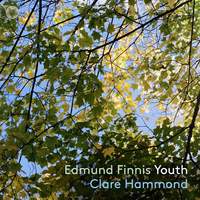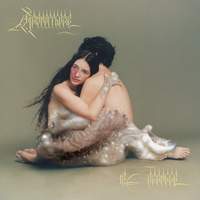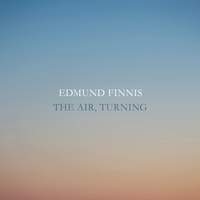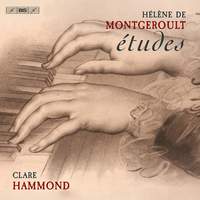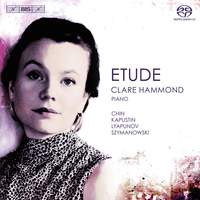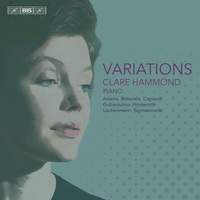Interview,
Edmund Finnis & Clare Hammond on Youth

The British composer Edmund Finnis (b.1984) won the Premiere category at the 2020 BBC Music Magazine Awards for The Air, Turning - a collection of chamber and orchestral music, taking its title from a 2016 work commissioned by the BBC Scottish Symphony Orchestra and also featuring pieces composed for London Contemporary Orchestra, Birmingham Contemporary Music Group and Mark Simpson & Víkingur Ólafsson.
His first collection of piano pieces, Youth, was recently released as an EP on Pentatone, recorded by his long-term friend Clare Hammond; the three of us got together via video-call to chat about some of the visual inspirations behind the music, how they both learned to stop 'hiding behind lots of notes', the joys of writing and performing works to mark special occasions, and their upcoming recording plans...
When did the pair of you first cross paths, and how long has this collaboration been in the works?
CH: It’s certainly been in my mind for many years, and I think that’s true of Ed as well. We met when we were doing a Masters at Guildhall, and very early on we decided we’d like to work together one day. It wasn’t until the spring of 2018 that I gave the premiere of Youth, so there was quite a long lead-time between having the idea and it coming to fruition. I’m friends with a lot of composers, but it was really nice to work with someone I’d known for so long and admire as much as I do Ed; it was such a lovely experience for me.
EF: And for me: Clare has such wonderful focus, poise and lucidity that I sat through the recording-sessions with a big smile on my face!
Quite a lot of the ideas in Youth had actually been around for a very long time. These are the first pieces I’ve written for solo piano; I’d done a lot of orchestral and chamber music but not yet crystallised how I wanted to write for the instrument, and in a way it felt like teaching myself from scratch. I don’t perform as a pianist, but I play almost every day as part of my composing work.
When I was working on the pieces, the word ‘Youth’ was in my mind all the time - partly because the cycle is dedicated to my nieces and nephews, who were then younger! And I like it when titles suggest some kind of image: not necessarily something specific, just something that offers a way into the music which might be different for each and every person that encounters it.
Where did you start with the cycle, and are there any thematic connections with your earlier works?
EF: ‘Helsinki Patterns’ is the final piece in Youth, but it was actually the first one that I wrote: the story behind that is that it’s a radical simplification of the notes that are in my first orchestral piece, which was premiered in Helsinki. The piano piece was written much later, but it was a way of me revisiting the material from a work which begins very brashly and noisily - it opens with groups of ninths in sequence, and I was interested in just looking at the pitches almost as if they were a skeleton.
Two pieces in Youth pay homage to painters: ‘Buren’ and ‘Frankenthaler’. How much inspiration do you draw from the visual arts, and how do you translate that into sound?
EF: I definitely have what Morton Feldman calls ‘painter-envy’, and he describes that as a very helpful thing for a composer to have. Ideas often occur to me when I’m engaging with something that’s non-musical: I often find that something just clicks in my mind on encountering certain artworks, usually in terms of the texture or atmosphere that I want to create. Helen Frankenthaler often saturates the canvas with washes of paint, and that got me thinking about the pedal of the piano: capturing resonance, letting things really ring on for a long time.

Agnes Martin is a very inspiring artist for me, and the title 'Coenties Slip' refers to an area of Manhattan where she lived for a while in the 1950s; I saw these beautiful photos of her and some of the artists in the neighbourhood riding bikes very close to the Wall Street financial district. There was something special about that New York artist scene back then, and it doesn’t exist in the same way anymore.
Martin is a very clear example of what I was talking about in terms of getting to the essence of things: often her paintings are just grids of different colours, and when you first encounter them they seem very simple in their forms. But as you spend time with them you start to perceive all sorts of details - places where washes of colour are more intense on the canvas, places where the hand-drawn lines have slightly wavered etc.
Another great artist who passed away recently was Robert Irwin; I read a book of conversations with him talking about his ideas and artistic trajectory, and again it was a case of trying to find the balance between what you’re trying to say as an artist and then letting whoever is perceiving your art have their own encounter with it. I’m very interested in creating that space in my music, and that’s partly why I often go for titles which suggest a general idea rather than being explicitly programmatic.
Clare, how do those ideas resonate with you from a performer’s perspective?
CH: This is music of suggestion: it’s less about things developing and more about entering into a certain state of mind. Particularly in something like 'Stream of Days' where you have a lot of repeating motifs all the way through, it’s as if the music’s always existed and you’re just joining it for a little while then popping off again! There’s a very strong emotional connection that you can’t really put into words: it’s very powerful despite being quite simple, which I think is a great strength.
I do a lot of contemporary music, and often when composers write for me they tend to focus on what they see as my strengths. That’s often crazily virtuosic music which is texturally very dense, but Youth is at the opposite end of the spectrum; it’s definitely one of the simpler pieces that I play, so I had to really dig down and find an individual approach. There’s a wonderful subtlety to the harmonic language that Ed uses, and the colour and glow that he achieves.
For me, having fewer notes made it so much more important to think about things like line and the emotion behind it. Particularly when I was younger, I used to use very dense textures as something to hide behind - as long as you got round the notes then you didn’t have to worry too much about the space between them! But with Ed’s pieces you do have to think about those spaces, so for me as a performer that was one of the main challenges and rewards of these pieces.

In terms of textures, I thought I heard slight echoes of Debussy and Ravel in one or two pieces... was that a conscious homage?
EF: It wasn’t conscious, but I’m sure all kinds of things happened subconsciously! In one sense I was trying to keep my mind clear of things that I already knew, but inevitably certain things that you play when you’re younger somehow stay in your hands. I’m quite interested in all those mental tricks that you have to play when you’re composing – I try to listen very widely and maintain my curiosity in music old and new, but when I’m writing something I want to wear that knowledge lightly.
CH: Certain energies reminded me of other pieces, but only in the way that things might remind me of a character in a book. Something about the energy of Spin reminded me of the Schumann Humoreske which I’d been playing just beforehand, but those are quite subtle kinships: Ed’s music is very much his own style, and that’s another joy. When you haven’t played anything by a composer before, it’s all about feeling your way into their style and trying to find their unique voice: that’s often what takes the most time, even with pieces that are very note-heavy.
EF: I can really relate to what Clare says about hiding behind pieces with lots of notes, because I think a very similar thing happened from a composer perspective at a certain point in my studies. I wanted to stop throwing lots of notes at things, and these pieces are absolutely attempts to communicate ideas in as clean a way as possible. To return to the idea of visual arts, a lot of the artists who’ve been important to me have this ability to get to the essence of something rather than hitting you with an overload of sensory stimulus. I’m very drawn to artists who can express themselves with clarity, elegance and character, so that when I encounter one of their works I know it’s them straight away.
CH: It’s interesting to hear you say that, Ed, because I think that’s exactly what your music does!
Tell me a little about the gorgeous Lullaby for Emmeline which closes the album…
CH: When my first daughter was born Robert Saxton wrote a lullaby for her, and I thought it would be lovely for Emmie to have one too. Ed’s whole language seemed perfect for that, and what he’s written is so beautiful - almost like a crystal suspended in the air! I was trying to explain to Emmie how it was composed and recorded and put out there online, and that quite a lot of people have now streamed ‘her’ piece, but she doesn’t get it at all just yet!
EF: It’s great that it’s gaining traction on streaming, but the most important moment was having Emmie in the room and playing it in front of her! I love this idea of music for occasions: music can form signposts in our lives, and I think that’s a wonderful thing. We all build such strong associations with pieces of music (or even with moments in a particular piece), and I’m very keen to use my music to express joy and wonder and awe of life. I have two children now but when I wrote this piece I didn’t, so I’m even more happy to have written something to celebrate a new life!
What’s next for you both in terms of upcoming recordings?
CH: My next recording-project will be concertos by Britten, Tippett and Walton with the BBC Symphony Orchestra – the Tippett and Walton sessions are in March, so I’m currently hard at work preparing for those! I knew when I started learning the Tippett that I was climbing a mountain, but it’s turned out to be a different kind of mountain from the one I was expecting…it’s not been so difficult to get the notes under my fingers, but I still have a lot of digging to do in terms of finding the voice and unpacking how it tracks with the orchestral parts…
EF: My Hymn (after Byrd) for string orchestra is coming out in March, which is a new version of a movement from my first string quartet, ‘Aloysius’. We recorded that with 12 Ensemble in March of last year, and it was a really wonderful day working with them in Abbey Road. Then there’s a song cycle that I wrote for Ruby Hughes and Manchester Collective called Out of the Dawn’s Mind, setting poems by Alice Oswald; that’s already recorded, and I hope it will come out some time this year…
Clare Hammond (piano)
Available Formats: MP3, FLAC, Hi-Res FLAC
12 Ensemble, Max Ruisi, Eloisa-Fleur Thom
Available Formats: MP3, FLAC, Hi-Res FLAC
Eloisa-Fleur Thorn (violin), Mark Simpson (clarinet), Víkingur Ólafsson (piano), Benjamin Bellman (violin)
BBC Scottish Symphony Orchestra, Birmingham Contemporary Music Group, London Contemporary Orchestra, Britten Sinfonia, Ilan Volkov, Richard Baker, Andrew Gourlay
Available Formats: CD, MP3, FLAC
Clare Hammond (piano)
Available Formats: SACD, MP3, FLAC, Hi-Res FLAC
Clare Hammond (piano)
Available Formats: SACD, MP3, FLAC
Clare Hammond (piano)
Available Formats: SACD, MP3, FLAC, Hi-Res FLAC


